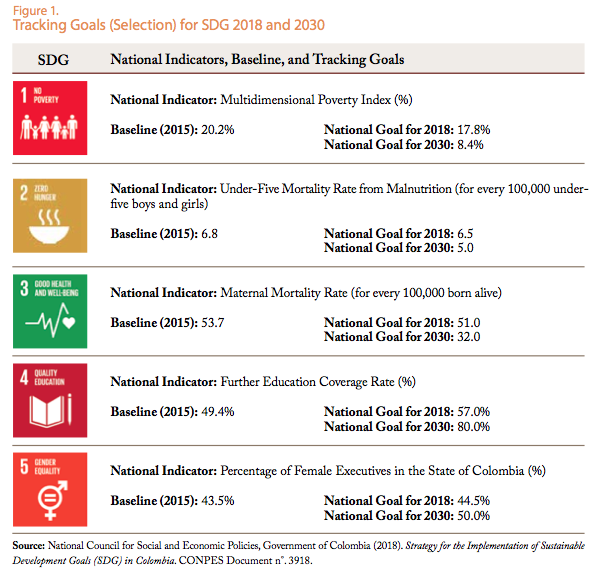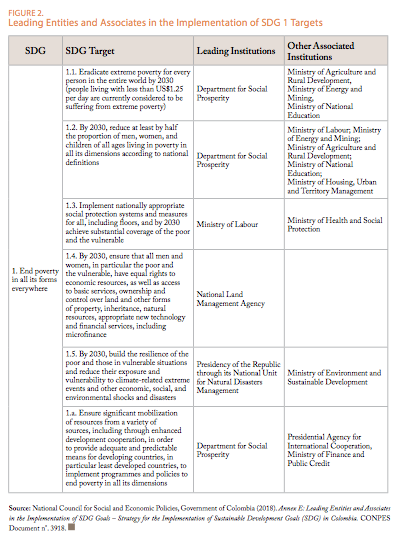
Search
Monitoring SDGs through an MPI: The Case of Colombia

In 2015, the United Nations member states adopted the 2030 Agenda for Sustainable Development. Its core mandate is the improvement in the quality people’s lives while leaving no one behind. For this reason, a set of 17 goals – the SDGs – were defined with the aim of monitoring the progress of each country. In particular, Target 1.2 is concerned with reducing the proportion of men, women, and children of all ages living in poverty in all its dimensions by at least half, according to national definitions, by 2030.
A recurrent question that has arisen among the representatives of several countries ever since is, which indicator should be used to measure the reduction of poverty in all its dimensions? Additionally, the guiding principle of these goals – to leave no one behind – imposes the necessity of understanding who are the poorest among the poor – those who suffer a greater number of deprivations in all its dimensions at the same time – and understanding which are the most relevant interconnections in order to guarantee the efficiency of poverty reduction policies. In other words, it demands to know who is being left behind in multiple dimensions at the same time and not just who is being left behind in particular dimensions – as progress in development goals is usually measured.
These questions have led a number of countries to support the incorporation of the MPI as an official SDGs indicator at the UN – an indicator that provides answers to some of these questions.
One such country is Colombia, whose government has launched the Strategy for the Implementation of Sustainable Development Goals in Colombia, which is articulated in document no. 3918 of the Colombian National Council for Social and Economic Policies (Conpes in Spanish). This strategy defines a monitoring and reporting framework for advancements in the implementation of the SDGs in Colombia that is based on a set of national indicators and which includes a baseline for each indicator and its respective goal for 2030.
It also outlines a plan to strengthen statistical production in order to be able to measure all aspects concerning the SDGs, as well as clear guidelines for the regionalisation of the goals. Finally, it establishes concrete actions for dialogue with non-governmental actors and thus promotes a multi-actor approach towards the achievement of these goals.
The monitoring and reporting mechanism for the implementation of the SDGs establishes 156 indicators to measure progress towards the attainment of the SDGs, names the lead institutions for each indicator – given that, in some cases, several entities are in charge of one indicator – and determines the resources necessary to reach the goals. A particularly relevant aspect is that, considering the high number of indicators, the Government of Colombia has decided to establish 16 trakcing indicators that will be monitored especially closely; the government has also created a monitoring framework to determine the resources necessary to fund the SDGs. The Multidimensional Poverty Index of Colombia (MPI-CO) was defined as one of the tracking indicators in the strategy to achieve the SDGs.
The incorporation of MPI-CO as a tracking indicator of the SDG Agenda confirms that a multidimensional approach on poverty and the interdependence of the SDGs has been established in Colombia.
The Government of Colombia has specifically chosen to use the MPI as a tracking indicator to monitor accomplishments related to SDG 1, as can be observed in Figure 1. This figure also shows the identified baseline (20.2% of people in multidimensional poverty in the year 2015) and the goals established for the years 2018 and 2030 (17.8% and 8.4%, respectively). The lead institutions responsible for each goal have also been clearly established (see Figure 2). More information on this strategy can be found on the portal https://www.ods.gov.co/goals/1.
The incorporation of MPI-CO as a tracking indicator of the SDG Agenda confirms that a multidimensional approach on poverty and the interdependence of the SDGs has been established in Colombia. It also shows that the Government of Colombia has decided to continue using a measurement tool that has been extremely useful as a guide for public policy and coordination. Furthermore, it demonstrates that the government intends to fully exploit the advantages of this tool, such as its capacity to capture the multiple deprivations that people suffer simultaneously and the possibility of disaggregating data by region, sex, age, etc. , in order to abide by the guiding principle of the SDG Agenda – to leave no one behind.
Original in Spanish. Translated by Elena Hall.
Read 5th Dimensions Issue here.


















